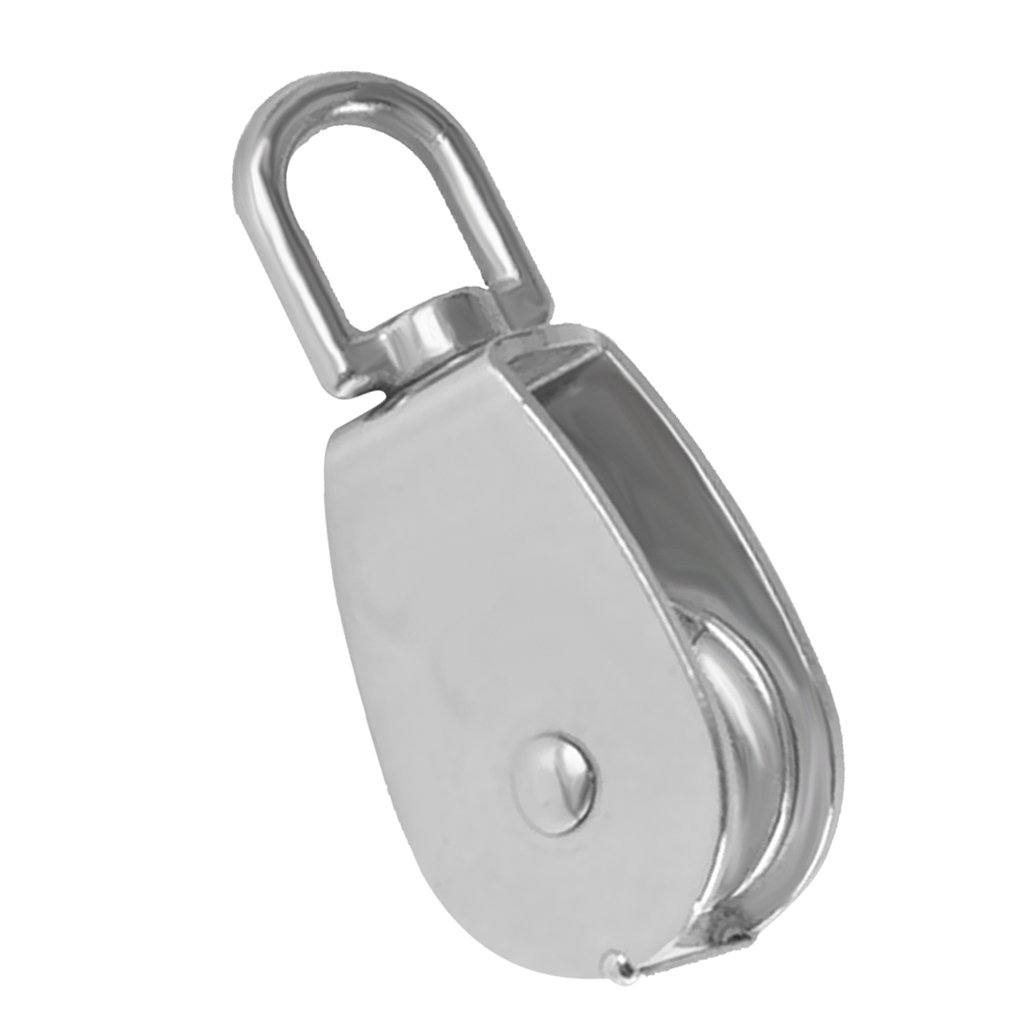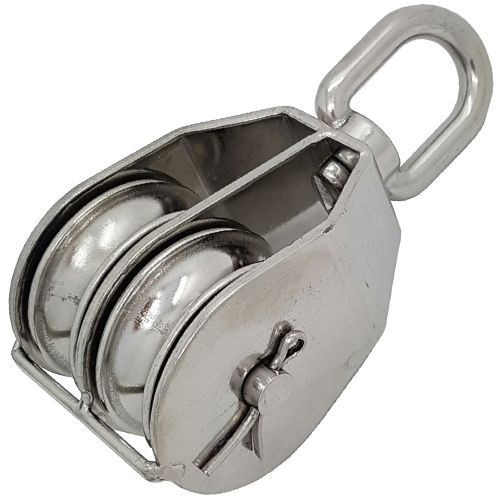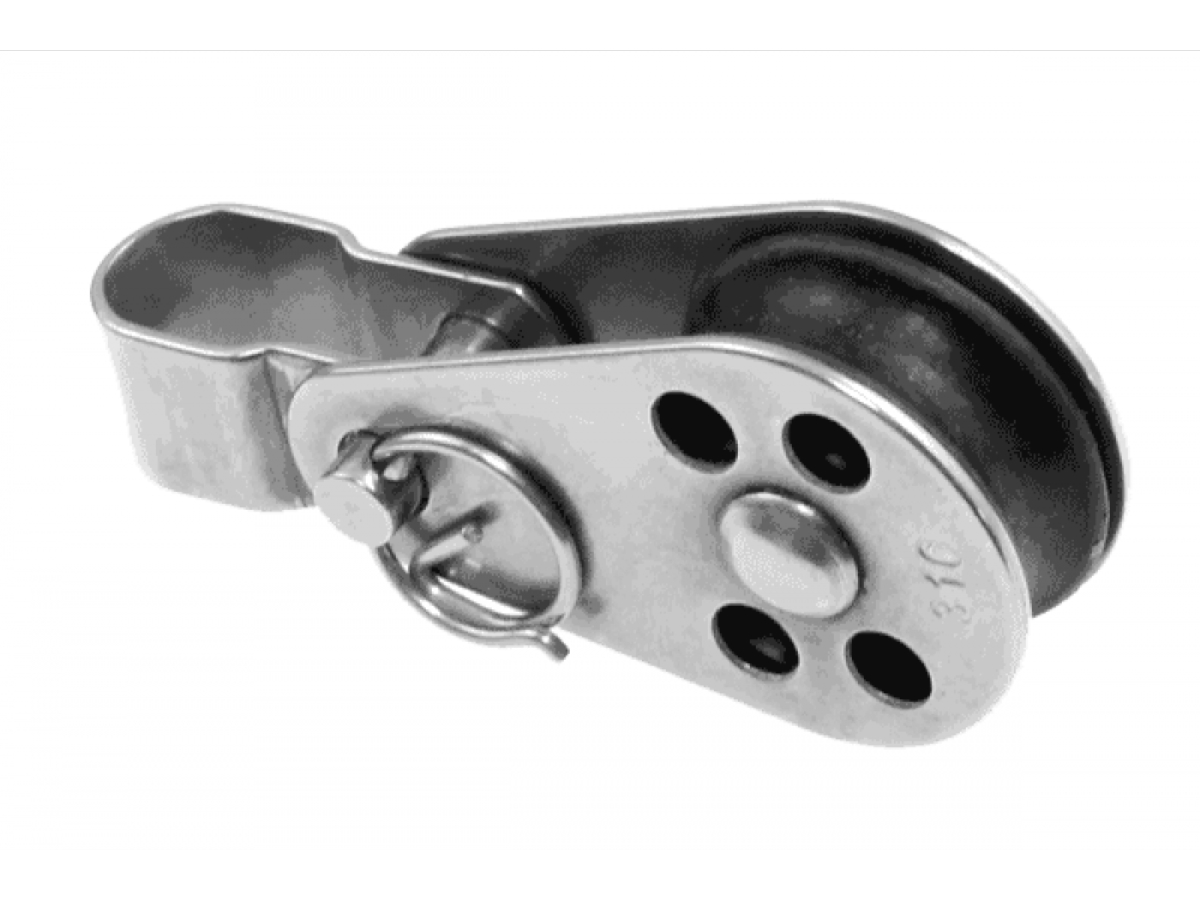Product Description
Product Description
Material: stainless steel 304
Product introduction: single wheel (double wheels) pulley can fit multiple rope sizes ranging from 25mm to 50mm.This block body and the removable sheave are made of stainless steel for corrosion resistance and durability. It’s suitable for industrial rigging applications. Match for kinds of stainless steel wire rope.
| Details of the figure | Detailed sizes | |||||
| Size | A | B | C | D | E | |
| mm | mm | mm | mm | mm | mm | |
| M15 | 12 | 13 | 61 | 15 | 6 | |
| M20 | 13.5 | 17.5 | 72 | 20 | 7 | |
| M25 | 15 | 20 | 83 | 25 | 11 | |
| M32 | 15 | 19.5 | 88 | 30 | 12 | |
| M50 | 19 | 23 | 117.5 | 48.5 | 13 | |
| Details of the figure | Detailed sizes | |||||
| Size | A | B | C | D | E | |
| mm | mm | mm | mm | mm | mm | |
| M15 | 12.5 | 13 | 61 | 15 | 5.5 | |
| M20 | 14 | 18 | 73 | 20 | 6.5 | |
| M25 | 16 | 20 | 85 | 25 | 10 | |
| M32 | 15.5 | 20 | 92.5 | 30 | 10 | |
| M50 | 19 | 31 | 132.5 | 50 | 13 | |
| Details of the figure | Detailed sizes | |||||
| Size | A | B | C | D | E | |
| mm | mm | mm | mm | mm | mm | |
| M75 | 23 | 33 | 155 | 75 | 15 | |
| M100 | 25 | 40 | 191 | 100 | 17 | |
Detailed Photos
Certifications
Company Profile
ZheJiang CHINAMFG Metal Products Co., Ltd. offers a variety of products which can meet your multifarious demands.
We adhere to the management principles of “quality first, customer first and credit-based” since the establishment of the company and always do our best to satisfy potential needs of our customers.
| Surface: | Bright Smooth |
|---|---|
| Material: | Stainless Steel 304 |
| Size: | 15mm-100mm |
| Samples: |
US$ 5/Piece
1 Piece(Min.Order) | Order Sample |
|---|
| Customization: |
Available
| Customized Request |
|---|
.shipping-cost-tm .tm-status-off{background: none;padding:0;color: #1470cc}
| Shipping Cost:
Estimated freight per unit. |
about shipping cost and estimated delivery time. |
|---|
| Payment Method: |
|
|---|---|
|
Initial Payment Full Payment |
| Currency: | US$ |
|---|
| Return&refunds: | You can apply for a refund up to 30 days after receipt of the products. |
|---|

How do you select the right stainless pulley configuration for a specific task?
Selecting the right stainless pulley configuration for a specific task involves considering several factors to ensure optimal performance and compatibility. Here’s a step-by-step guide:
- Identify the Application Requirements: Understand the specific requirements of the task or application. Consider factors such as load capacity, speed, torque, and environmental conditions. This information will help determine the appropriate pulley size, design, and material.
- Determine the Pulley Type: Choose the most suitable pulley type for the task. Options include flat-faced pulleys, V-belt pulleys, timing pulleys, or specialty pulleys. The choice depends on the power transmission method, belt or rope type, and the desired accuracy or functionality required for the task.
- Calculate Pulley Size: Calculate the required pulley size based on the desired speed ratio, belt or rope pitch diameter, and the desired operating speed. Consider the pulley’s diameter, width, and groove dimensions to ensure compatibility with the system components and achieve the desired power transmission performance.
- Consider Pulley Material: Choose a stainless pulley material suitable for the specific task. Consider factors such as corrosion resistance, durability, and environmental conditions. Stainless steel alloys like 304 or 316 are commonly used for their corrosion resistance, while specialty alloys may be required for extreme conditions or specific industry requirements.
- Evaluate Pulley Design Features: Assess additional design features that may be necessary for the task. This could include flanges, grooves, keyways, or specific mounting options. These features ensure proper belt or rope alignment, prevent slippage, and provide compatibility with other system components.
- Consider Pulley Accessories: Determine if any accessories or components are needed for the pulley configuration. This could include bearings, bushings, shafts, or mounting hardware. Select accessories that are compatible with the pulley design and facilitate smooth operation and easy installation.
- Review Industry Standards and Regulations: Ensure that the selected pulley configuration meets relevant industry standards, regulations, and safety requirements. This is particularly important in industries such as aerospace, automotive, or medical, where strict compliance is necessary.
- Consult with Experts: When in doubt, consult with pulley manufacturers, engineers, or industry experts. They can provide valuable guidance and expertise in selecting the right stainless pulley configuration for the specific task.
By following these steps and considering the application requirements, pulley type, size, material, design features, accessories, industry standards, and seeking expert advice, you can select the appropriate stainless pulley configuration that will ensure optimal performance, reliability, and safety for the specific task at hand.

How are stainless pulleys customized for specific applications and load-bearing requirements?
Stainless pulleys can be customized to meet specific applications and load-bearing requirements. Here are some common methods and considerations for customizing stainless pulleys:
- Size and Dimensions: Stainless pulleys can be manufactured in various sizes and dimensions to accommodate different belt widths, rope diameters, or cable sizes. Customizing the size ensures proper fit and alignment with the rest of the system.
- Load Capacity: The load-bearing capacity of a pulley is a critical factor in its customization. Stainless pulleys can be designed to handle specific load requirements by adjusting the material thickness, reinforcing the structure, or using high-strength stainless steel alloys.
- Bearing Type: Pulleys can utilize different types of bearings depending on the application requirements. Customization involves selecting the appropriate bearing type, such as ball bearings or roller bearings, to ensure smooth rotation and efficient power transmission.
- Coatings and Finishes: Stainless pulleys can be customized with coatings or finishes to enhance their performance. For example, a non-stick coating can be applied to reduce friction and prevent material buildup. Corrosion-resistant coatings can be used for added protection in corrosive environments.
- Special Features: Depending on the application, stainless pulleys can be customized with special features. This may include flanges, grooves, or specific profiles to accommodate unique belt or rope configurations. Custom features can optimize the pulley’s interaction with the rest of the system.
- Environmental Considerations: Customization of stainless pulleys also takes into account the specific environmental conditions in which they will be used. Factors such as temperature extremes, exposure to chemicals or moisture, or compliance with industry regulations are considered to ensure the pulleys are suitable for the intended environment.
Customizing stainless pulleys for specific applications and load-bearing requirements requires collaboration between pulley manufacturers, engineers, and end-users. By considering factors such as size, load capacity, bearing type, coatings, special features, and environmental conditions, stainless pulleys can be tailored to provide optimal performance, reliability, and longevity in a wide range of industrial applications.

What types of materials are typically used for the sheaves or wheels of stainless pulleys?
The sheaves or wheels of stainless pulleys are typically made from various materials to meet specific performance requirements. Here are some common materials used for the sheaves or wheels of stainless pulleys:
- Stainless Steel: Stainless steel sheaves or wheels are commonly used in stainless pulleys to ensure compatibility and consistency in terms of corrosion resistance and durability. Stainless steel sheaves can be made from the same stainless steel grade as the pulley body, providing a cohesive and robust construction.
- Nylon: Nylon is a popular choice for sheaves or wheels in stainless pulleys due to its excellent wear resistance, low friction coefficient, and self-lubricating properties. Nylon sheaves are lightweight, durable, and suitable for applications that require quiet and smooth operation.
- Acetal: Acetal, also known as polyoxymethylene (POM), is another material used for sheaves or wheels in stainless pulleys. Acetal sheaves offer good mechanical strength, wear resistance, and low friction characteristics. They are often chosen for applications that involve high speeds or where chemical resistance is required.
- UHMW (Ultra-High Molecular Weight Polyethylene): UHMW is a high-performance plastic known for its exceptional impact strength, abrasion resistance, and self-lubricating properties. UHMW sheaves or wheels are suitable for heavy-duty applications where resistance to wear, impact, and noise reduction are important.
- Cast Iron: In certain industrial applications, particularly those involving heavy loads and high stress, cast iron sheaves or wheels may be used in stainless pulleys. Cast iron provides excellent strength and durability, making it suitable for demanding applications such as mining or construction.
- Aluminum: Aluminum sheaves or wheels are lightweight and offer good corrosion resistance. They are commonly used in stainless pulleys where weight reduction is desired without compromising strength and performance.
The selection of the sheave or wheel material depends on factors such as the specific application requirements, load capacity, environmental conditions, and desired performance characteristics. By choosing the appropriate material, stainless pulleys can achieve optimal functionality, durability, and efficiency in their respective applications.


editor by CX
2023-12-14